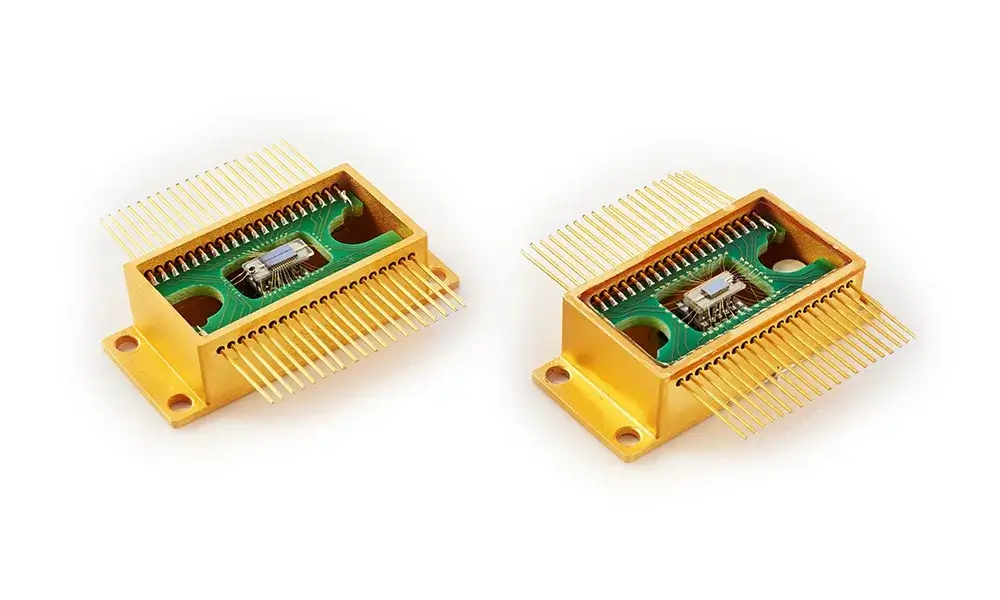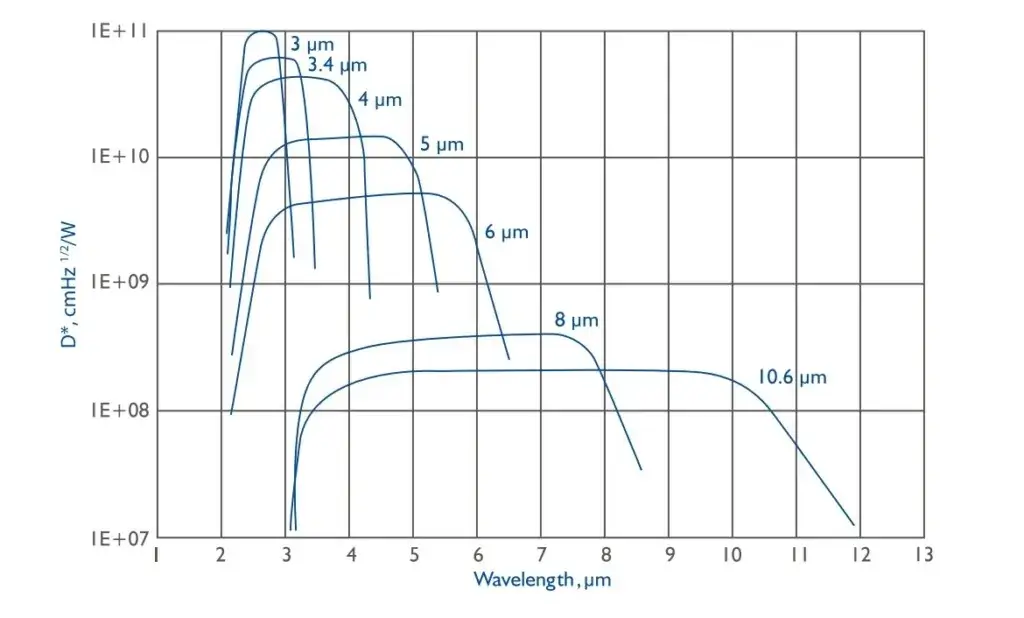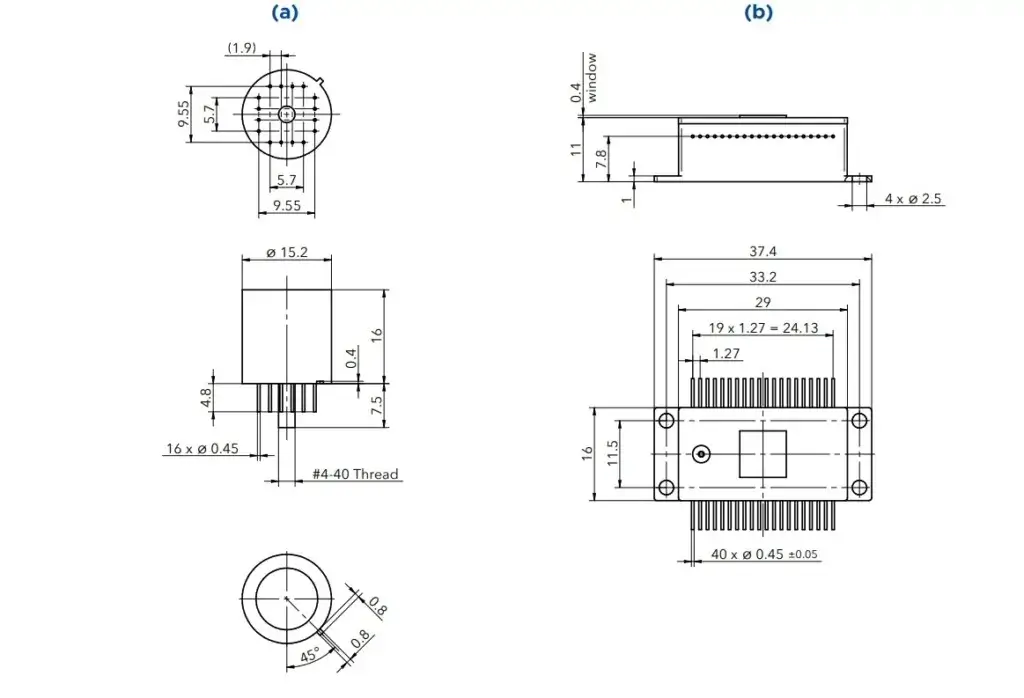Multielements Devices
VIGO Photonics’s 32-element array is now available, with dedicated preamplifier. The detectors line is a set of individual active elements and the signal of each of them is output independently. A multielement detector, unlike a single-element detector, allows to record radiation of different wavelengths at the same time.

Chart 1. Exemplary spectral detectivity

Our technological capabilities also allow the production of multielement detectors with InAsSb (indium arsenide antimonide) using the MBE (Molecular Beam Epitaxy) method.
These devices are complying with the RoHS Directive. They are designed for applications where higher resistance to difficult operating conditions should be ensured.
The great advantage of VIGO Photonics multielement detectors is that there is no need for cryogenic cooling. This results in a reduction in the size and weight of the device, and hence a reduction in power consumption.
Figure 1 shows the dimensions (unit: mm) of TO8 16pin (a) and flatpack 40pin (b) housings in which VIGO Photonics multielement detectors are mounted.
Figure 1. Mechanical layout

Key features of the product
Advantages:
– High sensitivity
– High-speed response
– Convenient cryogenic-free operation
The key advantages of VIGO Photonics multielement detectors are very high accuracy and measurement speed. In temperature measurements, accuracy of a single millikelvin is achieved, even when measuring an object present in the field of view for only a few microseconds.
In spectrophotometry, these advantages allow obtaining high-quality measurements in a short time. Measuring the entire spectral range at the same time shortens the measurement time (compared to the time needed for scanning and full spectrum analysis in one-piece detectors).
Table 2 presents the parameters of VIGO Photonics multielement detectors, selected for the needs of individual applications.
Table 2. Parameters
| Parameter | Value |
| Array format | linear or bilinear, up to 32 elements |
| Active elements material | HgCdTe or InAsSb |
| Detector type | PV (phtovoltaic) or PC (photoconductor) |
| Operating wavelength | MWIR (λcut-off: 3.0 to 8.0 µm) LWIR (λcut-off: 8.0 to 14.0 µm) λcut-on can be optimized upon request |
| Pixel size | minimum 25×25 μm |
| Cooling | 2- or 3-stage TEC |
| Active elements temperature | 210 – 270 K |
| Temperature sensor | thermistor or diode (accuracy up to ±1 K) |
| Time constant | 1 – 500 ns |
| Package | TO8 16pin or flatpack 40pin |
| Window | Si/Al2O3/Ge with or without anti-reflection coating, planar or wedged |
| Ambient temperature | 0 to 70°C |
| Storage temperature | -20 to 50°C |
VIGO Photonics multielement detectors are offered with a wide range of accessories. Accessories can be tailored to the needs of application and integration with the user’s system.
Table 3 shows the examples of solutions.
| Accessory | Description |
| TEC controller | onboard analog controller |
| Lens mount | C-mount 1” or SM1 THORLABS |
| Preamplifier | ultra-low noise, selectable bandwidth |
| DAQ | SPI or USB HS |

AM03120-01, Affordable MWIR InAsSb detection module, is an ”all-in-one” uncooled IR detection module in a compact TO8 package. Photovoltaic mutiple junction InAsSb detector element is directly integrated with a low-noise preamplifier. Amplified analog output may be connected directly to the measurement equipment. Through-hole mounting is possible.
The detection module is supplied with an anti-reflection coated window preventing unwanted interference effects. The final product can be offered as an OEM component (only PCB with detector element), mounted on a TO8 sumbount or mounted and sealed in a TO8 package with a window.
Table 1. Specification (TA = 20°C, RL = 1 MΩ, F0 = 500 KHZ)*
| Parameter | Min | Typ | Max |
| Cut-on wavelength λcut-on (10%), µm | – | 2.3 | – |
| Peak wavelength λpeak, µm | 4.4 | 4.6 | 4.7 |
| Cut-off wavelength λcut-off (10%), µm | – | 5.9 | – |
| Detectivity D*(λpeak), cm·Hz1/2/W | 3.4×108 | 5.5×108 | – |
| Output noise voltage density vn, nV/Hz1/2 | – | 100 | 130 |
| Noise equivalent power NEP(λpeak), nW/Hz1/2 | – | 0.18 | 0.30 |
| Voltage responsivity Rv(λpeak), V/W | – | 559 | – |
| Low cut-off frequency flo, Hz | – | DC | – |
| High cut-off frequency fhi, Hz | 2M | – | – |
| Transimpedance Ki, V/A | 4.65k | 4.70k | 4.75k |
| Output impedance Rout, Ω | 49.5 | 50.0 | 50.5 |
| Output voltage Vout, V | 0 0 |
– – |
2.50 (RL = 1 MΩ) 1.25 (RL = 50 Ω) |
| Output voltage offset Voff, mV | -10 | – | +10 |
| Power supply voltage Vsup, V | – | ±3 | – |
| Power supply current Isup, mA | – | – | 20 |
| Power consumption, mW | – | – | 120 |
| Active element material | epitaxial InAsSb heterostructure | ||
| Active area A, mm×mm | 1×1 | ||
| Package | TO8 | ||
| Acceptance angle Φ | ~48° | ||
| Window | wZnSeAR | ||
The modules are easy to use thanks to:
– signal already amplified, voltage output,
– availability on a standard submount (TO8),
– availability for a direct mounting onto user’s PCB (OEM version),
– small size.
Affordable MWIR InAsSb detection module (AM03120-01) is available for purchase in three options. AM03120 is a detector in the TO8 package. AM03110 is a detector on a steel base. It is also possible to order a miniaturized chip, size 10 x 10 x 3 mm, with an amplifier on the PCB – AM03100. Below are the options described:
Applications
Affordable detection module is used in various applications. Due to its high speed response, it is suitable for applications when MWIR fast pulse laser carries information, for example MWIR spectroscopy. Affordable module is designed for space limited and low power applications. It saves space due to a built-in trans-impedance preamplifier which is not necessary in customer’s application. Its added benefit is a low power consumption which suits, i.e., battery operation devices. Remaining applications are the following: laser metrology, monitoring of industrial and laboratory processes, laser power monitoring and control. The device is being developed in terms of creating new features: digital output, thermoelectric cooling etc.

Access to file
Access to this file is limited. In order to download it, please provide all the information and submit the form.
Application notes
























